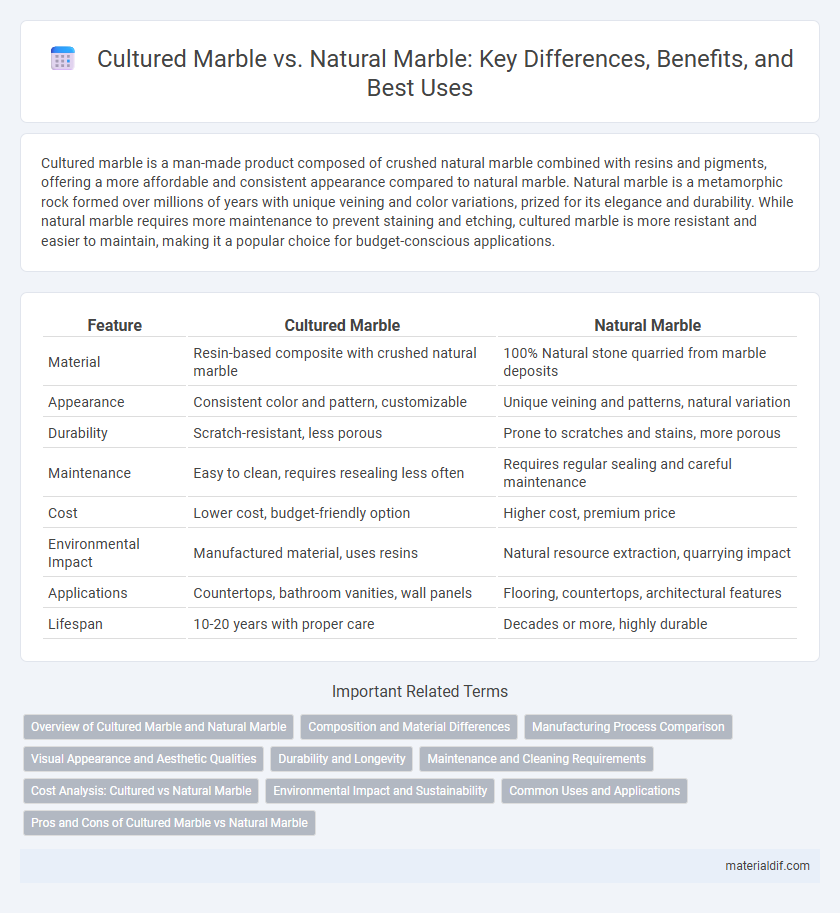Cultured marble is a man-made product composed of crushed natural marble combined with resins and pigments, offering a more affordable and consistent appearance compared to natural marble. Natural marble is a metamorphic rock formed over millions of years with unique veining and color variations, prized for its elegance and durability. While natural marble requires more maintenance to prevent staining and etching, cultured marble is more resistant and easier to maintain, making it a popular choice for budget-conscious applications.
Table of Comparison
| Feature | Cultured Marble | Natural Marble |
|---|---|---|
| Material | Resin-based composite with crushed natural marble | 100% Natural stone quarried from marble deposits |
| Appearance | Consistent color and pattern, customizable | Unique veining and patterns, natural variation |
| Durability | Scratch-resistant, less porous | Prone to scratches and stains, more porous |
| Maintenance | Easy to clean, requires resealing less often | Requires regular sealing and careful maintenance |
| Cost | Lower cost, budget-friendly option | Higher cost, premium price |
| Environmental Impact | Manufactured material, uses resins | Natural resource extraction, quarrying impact |
| Applications | Countertops, bathroom vanities, wall panels | Flooring, countertops, architectural features |
| Lifespan | 10-20 years with proper care | Decades or more, highly durable |
Overview of Cultured Marble and Natural Marble
Cultured marble is a man-made material composed of crushed limestone blended with resins and pigments, offering a cost-effective and versatile alternative to natural marble. Natural marble, formed through metamorphic processes, consists primarily of calcite and is prized for its unique veining and color variations created by mineral impurities. While cultured marble provides uniformity and ease of maintenance, natural marble stands out for its durability and distinct aesthetic appeal in architectural and design applications.
Composition and Material Differences
Cultured marble is a blend of crushed natural marble particles mixed with resins and pigments, creating a versatile, uniform surface that is non-porous and resistant to stains. Natural marble is a metamorphic rock composed primarily of calcite or dolomite minerals, characterized by its unique veining and porous structure prone to surface absorption and weathering. The engineered composition of cultured marble allows for greater durability and customization, while natural marble offers authentic aesthetic variations shaped by geological processes.
Manufacturing Process Comparison
Cultured marble is manufactured by combining crushed natural marble with resins and pigments, then molded into desired shapes using gel-coat molds, resulting in a non-porous, uniform surface. Natural marble is quarried directly from rock formations and then cut and polished, preserving its unique veining and natural variations but requiring sealing for durability. The manufacturing process of cultured marble allows for more consistent patterns and customization, while natural marble maintains its original geological characteristics.
Visual Appearance and Aesthetic Qualities
Cultured marble offers a consistent, uniform pattern with a glossy, polished finish, providing a sleek and modern aesthetic that mimics the look of natural marble. Natural marble displays unique, irregular veining and color variations due to its organic formation, giving each slab distinct character and a timeless, luxurious appeal. While cultured marble provides predictable color schemes and smooth surfaces ideal for contemporary designs, natural marble boasts a rich, tactile texture and depth that enhances classic and elegant interiors.
Durability and Longevity
Cultured marble offers enhanced durability due to its resin coating, making it more resistant to stains, scratches, and moisture compared to natural marble. Natural marble, composed of real stone, tends to be more porous and susceptible to etching and chipping over time, requiring regular sealing and maintenance. While cultured marble can maintain its appearance longer in high-traffic or wet areas, natural marble provides timeless elegance but demands careful upkeep to ensure longevity.
Maintenance and Cleaning Requirements
Cultured marble requires less maintenance than natural marble due to its non-porous surface, which resists staining and minimizes the need for sealing. Natural marble demands regular sealing and delicate cleaning with pH-neutral products to avoid etching and discoloration. Both materials benefit from prompt spill cleanup, but cultured marble offers greater durability and ease of care in high-use areas.
Cost Analysis: Cultured vs Natural Marble
Cultured marble typically costs between $30 and $60 per square foot, offering a more affordable option compared to natural marble, which ranges from $50 to $150 per square foot depending on the grade and origin. The manufacturing process of cultured marble, involving resin and natural marble dust, reduces material expenses and installation labor, making it cost-effective for countertops and bathroom surfaces. Natural marble's higher price reflects quarrying, cutting, and finishing costs, along with its unique veining and durability that can increase long-term value despite initial investment.
Environmental Impact and Sustainability
Cultured marble, made from resin and crushed stone, offers a lower environmental impact compared to natural marble by reducing quarrying-related habitat destruction and waste. Natural marble extraction involves significant energy consumption, extensive mining, and ecological disruption, contributing to higher carbon emissions. Cultured marble's sustainable production process includes recycled materials and less resource-intensive manufacturing, making it a more eco-friendly choice for environmentally conscious consumers.
Common Uses and Applications
Cultured marble is commonly used for bathroom vanities, shower surrounds, and countertops due to its durability, ease of maintenance, and cost-effectiveness. Natural marble is favored for high-end flooring, wall cladding, and decorative architectural elements because of its unique veining, natural beauty, and luxurious appeal. Both materials are suitable for indoor installations but differ in their application based on budget, aesthetics, and maintenance requirements.
Pros and Cons of Cultured Marble vs Natural Marble
Cultured marble offers advantages such as lower cost, consistent patterns, and greater resistance to stains and scratches compared to natural marble. However, natural marble provides unique, authentic veining and superior heat resistance, elevating aesthetic and functional appeal but requires regular sealing and is more prone to etching and staining. Choosing between cultured and natural marble depends on budget, maintenance commitment, and desired visual impact.
Cultured marble vs natural marble Infographic

 materialdif.com
materialdif.com